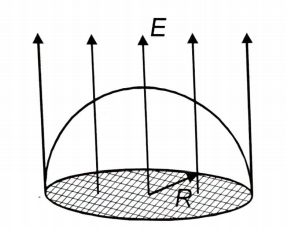Two charges of coulomb and coulomb are placed 6m apart. Find the electric field intensity ratio at points 4 m from the centre of the electric dipole (i) on the axial line (ii) on the equatorial line
1.
2.
3.
4.
The electric force on a point charge situated on the axis of a short dipole is F. If the charge is shifted along the axis to double the distance, the electric force acting will be:
1. 4F
2.
3.
4.
An electric dipole is placed at an angle with an electric field of strength N/C. It experiences a torque equal to Nm. Calculate the charge on the dipole, if the dipole is of length 4 cm.
1.
2.
3.
4.
A charge q is situated at the centre of a cube. The electric flux through one of the faces of the cube is:
1.
2.
3.
4. Zero
A charge Q is placed at the centre of the open end of a cylindrical vessel. The electric flux through the surface of the vessel is:
1.
2.
3.
4. Zero
A hemispherical surface of radius R is kept in a uniform electric field E as shown in the figure. The flux through the curved surface is:

1.
2.
3.
4. Zero
Total electric flux associated with a unit positive charge in a vacuum is:
1.
2.
3.
4.
A charged body has an electric flux F associated with it. Now if the body is placed inside a conducting shell, then the electric flux outside the shell is:
1. Zero
2. Greater than F
3. Less than F
4. Equal to F
A cylinder of radius R and length L is placed in a uniform electric field E parallel to the cylinder axis. The outward flux over the surface of the cylinder is given by:
1.
2.
3.
4.
A rectangular surface of sides 10 cm and 15 cm is placed inside a uniform electric field of 25 V/m such that the surface makes an angle of with the direction of the electric field. Find the flux of the electric field through the rectangular force.
1.
2.
3. Zero
4.






